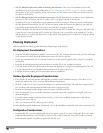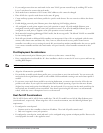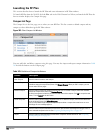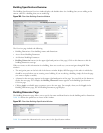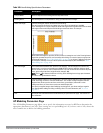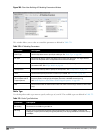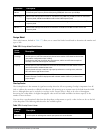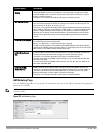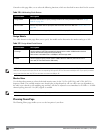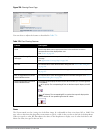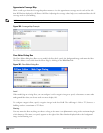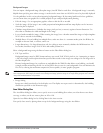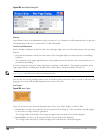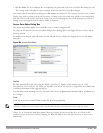
802 | RF Plan DellPowerConnectW-SeriesArubaOS6.2 | User Guide
Overlap
Factor
Description
150% Medium Use this option for most typical office environments with cubicles and sheetrock walls that have higher
WLAN user density than warehouses.
200% High Use this option for dense deployments such as buildings with poor RF coverage characteristics including
buildings with thick brick or concrete walls, lots of metal, or excess RF noise (for example, data centers).
Custom Use this option to enter a custom rate. For most office spaces, 120% works well.
When specifying the custom rate, the valid range is 1% to 1000%.
Users/AP
NOTE: The Users text boxes are active only when the Capacity model is selected.
Enter the number of users you expect to have on your WLAN in the Users text box. Enter the number of users per
AP you expect in the Users/AP text box.
The numbers entered in these two text boxes must be non-zero integers between 1-255 inclusive.
Radio Properties (Desired Rates and HT Support Options)
Define 802.11a, 802.11b/g, and 802.11n settings for the 5 GHz and 2.4 GHz frequency bands, including high-
throughput, data rates, and 40 Mhz channel spacing.
Radio Property Description
802.11a Desired Rate The desired 802.11a rate defines the estimated transmit rate within the WLAN coverage area.
The higher the speed, the smaller the coverage area, and the more APs required. The valid
values are: 54, 48, 36, 24, 18, 12, 9, 6.
This option is only available when 802.11n (HT) support is disabled (unchecked or grayed out).
When an 802.11n radio type, such as 802.11a + n or 802.11a/b/g + n, is selected and 802.11n (HT)
support is enabled (checked) on the 5 GHz band, the system will automatically define the
802.11a rate. The system looks at the defined 802.11n rate and the distance covered by the
defined rate; the system then selects a corresponding 802.11a rate based on the distance
covered.
5 GHz 802.11 (HT) Support High-throughput is available when utilizing the IEEE 802.11n standard and can be enabled on
the 5 GHz frequency band when either the 802.11a + n or 802.11a/b/g + n mixed-mode radio
type is selected.
The 802.11n (high-throughput) draft standard supports MIMO (Multiple Input, Multiple Output)
and the option of 40 MHz mode of operation. However, high-throughput can be utilized on a 20
MHz channel or on a 40 MHz channel (bonded channel pair).
5 GHz 802.11n Desired Rate The desired 802.11n rate defines the estimated transmit rate within the WLAN coverage area.
The higher the speed, the smaller the coverage area, and the more APs required.
This option is only available when 802.11n (HT) support is enabled (checked).
The valid values when using 20 MHz channel spacing: 6.5, 13.0, 19.5, 26.0, 39.0, 52.0, 58.5, 65.0,
78.0, 104.0, 117.0, 130.0.
The valid values when using 40 MHz channel spacing: 13.5, 27.0, 40.5, 54.0, 81.0, 108.0, 121.15,
135.0, 162.0, 216.0, 243.0, 270.0.
5 GHz Use 40 MHz Channel Use 40 MHz Channel Spacing—40 MHz operation, which supports higher data rates by
Table 374:
Radio Properties



